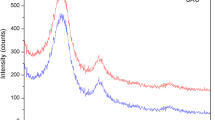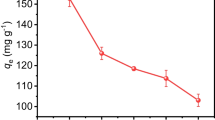A method for obtaining granulated absorbents from chitosan is presented. They are shown to be efficient for purifying wastewater from heavy-metal ions. IR spectra of the obtained absorbents are given. Processing schemes for obtaining granulated absorbents based on chitosan are developed. The antibacterial properties of chitosan are studied.




Similar content being viewed by others

References
K. G. Skryabin, G. A. Vikhoreva, and V. P. Varlamov (eds.), Chitin and Chitosan. Production, Properties and Use, Nauka, Moscow (2002).
L. S. Gal’braikh, “Chitin and chitosan: Structure, properties, use,” Soros. Obraz. Zh., 7, No. 1, 51–56 (2001).
L. F. Gorovoi and V. N. Kosyakov, “Absorption properties of chitin and its derivatives: Chitin, its structure and properties,” in: Chitin and Chitosan. Production, Properties and Use, Nauka, Moscow (2002), pp. 217–246.
T. M. Safronova, “Use of chitosan in food product manufacturing,” in: Chitin and Chitosan. Production, Properties and Use, Nauka, Moscow (2002), pp. 346–359.
A. M. Dubinskaya and A. E. Dobrotvorskii, “Utilization of chitin and its derivatives in pharmacy (review),” Khim.-Farm. Zh., 23, No. 5, 623–628 (1989).
V. M. Bykova, L. I. Krivosheina, O. I. Glazunov, and E. A. Ezhova, “Use of chitosan in medicinal cosmetics,” in: Progress in Chitin and Chitosan Research: Proc. 7th Int. Conf., VNIRO, Moscow (2003), pp. 231–233.
V. M. Bykova, E. A. Ezhova, and S. V. Nemtsev, “Several aspects of using chitin and chitosan as flocculants,” Agrar. Ross., No. 5, 30–31 (2004).
G. Gil, S. Del Monaco, and M. Galvagno, “Selective antimicrobial activity of chitosan on beer spoilage bacteria and brewing yeasts,” Biotechnol. Lett., 26, 576–574 (2004).
V. F. Abdullin, S. E. Artemenko, G. P. Ovchinnikova, and O. S. Arzamastsev, “Extraction processes in extraction of the biopolymer chitin from crab shells,” Khim. Volokna, No. 6, 21–24 (2008).
O. S. Arzamastsev, S. E. Artemenko, and V. F. Abdullin, “Intensification of the process for preparing chitosan films,” Vestn. Sarat. Gos. Tekh. Univ., No. 4 (60), Iss. 2, 112–114 (2011).
N. A. Sobgaida, V. F. Abdullin, N. A. Vlazneva, et al., “Use of chitosan to remove pollutants from model wastewaters,” Vestn. Kazan. Tekh. Univ., 17, No. 14, 397–400 (2014).
L. A. Ivanushko, T. F. Solov’eva, T. S. Zaporozhets, et al., “Antibacterial and antitoxic properties of chitosan and its derivatives,” Tikhookean. Med. Zh., No. 1, 18–25 (2009).
Author information
Authors and Affiliations
Corresponding author
Additional information
Translated from Khimicheskoe i Neftegazovoe Mashinostroenie, No. 5, pp. 42–44, May, 2016.
Rights and permissions
About this article
Cite this article
Taranovskaya, E.A., Sobgaida, N.A. & Markina, D.V. Technology for Obtaining and Using Granulated Absorbents Based on Chitosan. Chem Petrol Eng 52, 357–361 (2016). https://doi.org/10.1007/s10556-016-0200-y
Published:
Issue Date:
DOI: https://doi.org/10.1007/s10556-016-0200-y



